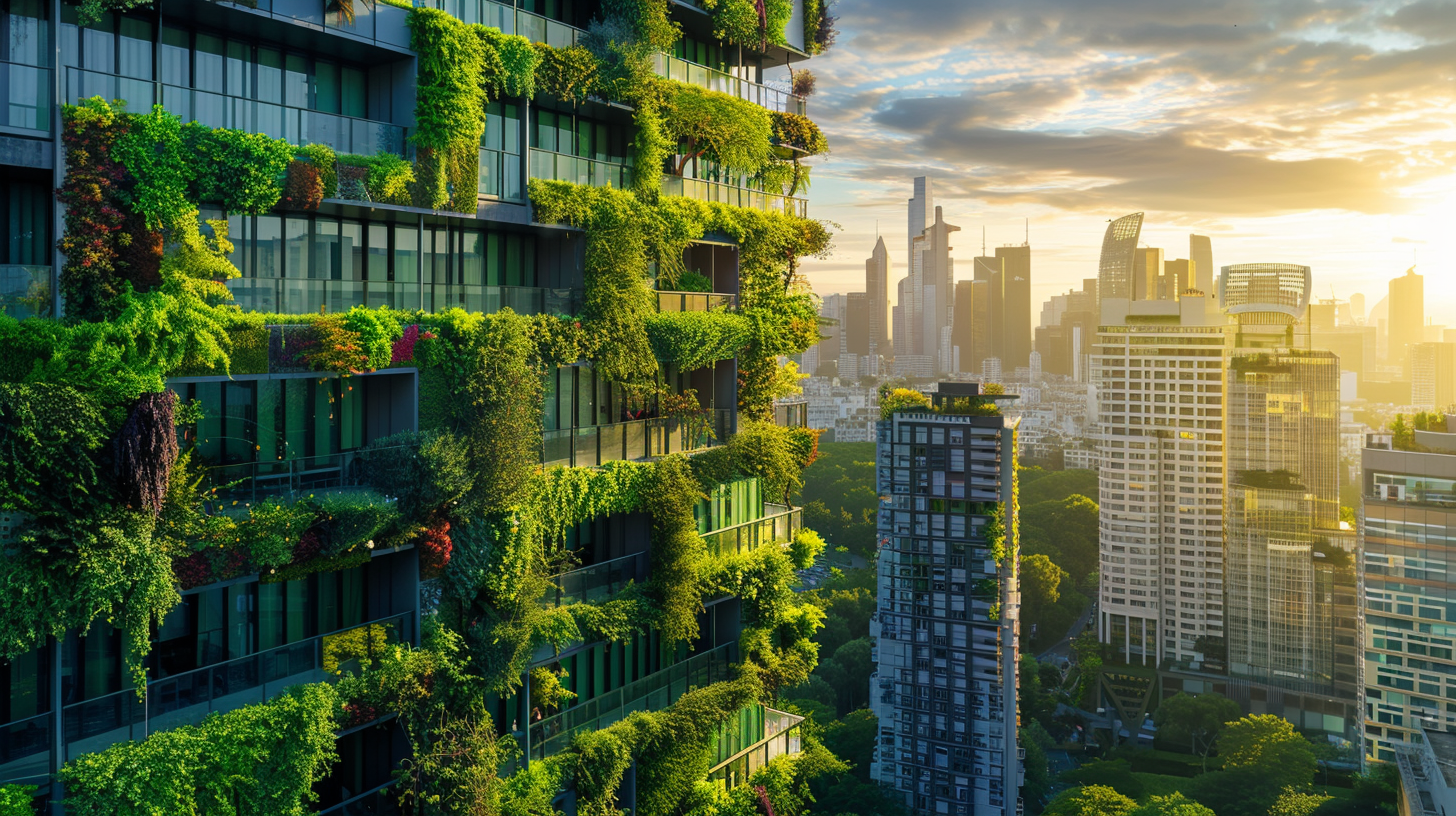Table of Contents Show
In a world teeming with concrete jungles, it’s the green cities that stand out as beacons of hope for environmental responsibility. We’re witnessing an inspiring shift towards urban sustainability, where innovations in renewable energy, green spaces, and eco-friendly policies are leading the charge. This movement isn’t just about reducing carbon footprints; it’s about creating a sustainable future that generations to come will thank us for. As we explore the pioneering efforts of these eco-cities, let’s ponder how their strategies can be a blueprint for others. What makes them so effective, and how can other cities follow suit? The answers might surprise you.
Key Takeaways
- Eco-cities promote sustainability through green spaces and renewable energy use.
- Urban areas are redesigning for waste minimization and energy-efficient buildings.
- Green transportation and community gardens enhance urban living and reduce pollution.
- Sustainable urban infrastructure supports climate resilience and improves community well-being.
The Rise of Eco-Cities
Across the globe, we’re witnessing the emergence of eco-cities, a transformative approach to urban living that champions sustainability. These innovative urban spaces are reshaping how we think about our environments, offering us the freedom to live in harmony with nature while thriving in vibrant communities. They’re not just about reducing carbon footprints; they’re about creating spaces where we can breathe easier, move freely, and connect more deeply with the world around us.
Eco-cities are built on the principle that urban areas can be designed to minimize waste, enhance green spaces, and promote healthier lifestyles. We’re seeing the rise of green buildings that not only save energy but also generate their own, through smart design and natural light. Public transportation systems are becoming more efficient and less polluting, making our commute less of a hassle and more of an experience.
Additionally, these cities encourage a community-focused way of life. They’re designed with public spaces that invite us to gather, share, and collaborate. Urban gardens and parks are not rare sights; they’re integral parts of the cityscape, ensuring that nature isn’t just a destination, but a daily presence in our lives.
We’re embracing the shift towards eco-cities because they offer us a path to freedom – freedom from pollution, from overcrowded living conditions, and from the unsustainable practices of the past. By championing sustainability, eco-cities are not only securing a healthier planet for future generations but are also crafting a more vibrant and fulfilling life for us all, right now.
Pioneering Renewable Energy
As we turn our attention to pioneering renewable energy, we’re seeing solar power and wind energy take center stage in urban sustainability efforts. Cities across the globe are harnessing these resources to not only cut down on carbon emissions but also to lead by example in the shift to cleaner energy sources. It’s clear that the integration of solar advancements and wind energy is important for paving the way towards a greener future.
Solar Power Advancements
Solar power advancements are revolutionizing how we harness the sun’s energy, making it a cornerstone of urban sustainability efforts. We’re witnessing a surge in innovative technologies that not only boost efficiency but also empower communities, offering a liberating shift towards energy independence. Here’s why this matters:
- Cost Reduction: Innovative manufacturing techniques are slashing solar panel costs, making clean energy more accessible to everyone.
- Efficiency Leap: Breakthroughs in photovoltaic technology mean we’re getting more power from less sunlight.
- Storage Solutions: Advanced batteries are enabling us to store solar energy, ensuring we’ve got power even when the sun isn’t shining.
- Community Empowerment: Solar initiatives support local economies and foster a sense of autonomy, giving us the freedom to choose a sustainable future.
Wind Energy Integration
In the quest for urban sustainability, integrating wind energy has become a key strategy alongside solar power advancements. We’re moving beyond traditional energy sources, embracing wind power to free ourselves from the grip of fossil fuels. It’s not just about cleaner air; it’s about granting our cities the autonomy they deserve in energy production. By harnessing the wind, we’re tapping into an inexhaustible resource, reducing our carbon footprint, and boosting local economies.
We’re seeing innovative wind turbines fitted onto buildings and open spaces, turning urban landscapes into power generators. This isn’t a distant dream—it’s happening now. Through community involvement and government support, we’re paving the way for a sustainable future. Wind energy isn’t just an alternative; it’s a declaration of our commitment to freedom and environmental responsibility.
Expanding Urban Green Spaces
We’re focusing on the essential task of expanding urban green spaces to enhance city living. It’s not just about adding a few parks here and there; it’s about integrating nature into our urban fabric, making our cities more livable, breathable, and vibrant. By prioritizing green spaces, we’re not only promoting environmental sustainability but also fostering a sense of freedom and well-being among city dwellers.
Here’s why expanding urban green spaces is critical:
-
Enhances Mental and Physical Health: Access to natural environments has been shown to reduce stress, improve mood, and encourage physical activity. We’re giving everyone the freedom to breathe cleaner air and find peace amidst the urban hustle.
-
Boosts Biodiversity: By creating more green spaces, we’re providing habitats for a variety of plants and animals. This biodiversity is not just beautiful—it’s a critical component of our urban ecosystem, contributing to its resilience and stability.
-
Improves Air Quality: Trees and plants act as natural air filters, absorbing pollutants and producing oxygen. We’re essentially planting the seeds for healthier, more breathable cities.
-
Mitigates Urban Heat Island Effect: Green spaces help cool down our cities by providing shade and releasing moisture into the air. This natural cooling system is especially essential as we face hotter temperatures due to climate change.
We’re not just dreaming of greener cities; we’re actively creating them. By expanding urban green spaces, we’re championing a vision where freedom, health, and sustainability are at the heart of urban living.
Innovations in Public Transport
As cities evolve, they’re increasingly turning to innovative public transport solutions to reduce congestion and environmental impact. We’re embracing technologies and ideas that make getting around not just easier, but also cleaner and more efficient. It’s about giving us all the freedom to move without contributing to the planet’s woes.
We’re seeing electric buses glide through city streets, quiet and emission-free, making our air cleaner. Cities are rolling out bike-sharing schemes that let us hop on and off at our convenience, blending exercise with eco-friendly travel. It’s a win-win for our health and the environment.
We’ve also got our eyes on the future with the rise of autonomous public transport. Imagine buses and trams that don’t just run on clean energy but operate without a driver, optimizing routes and reducing accidents. It’s about leveraging technology to give us a smoother, safer ride.
Furthermore, we’re not just sticking to the roads. Urban cable cars and improved ferry services are offering scenic and less congested routes for our daily commutes. It’s about rediscovering the joy of travel, escaping the gridlock, and seeing our cities from new perspectives.
It’s clear, as we push forward, we’re not just looking for ways to get from point A to B; we’re reimagining what public transport can be. It’s about creating systems that offer freedom, flexibility, and respect for our environment. As we continue to innovate, we’re not just moving people—we’re moving towards a brighter, cleaner future for all of us.
Sustainable Building Practices
Turning our attention to sustainable building practices, we’re focusing on two critical areas: eco-friendly materials and energy efficiency measures. By incorporating materials that minimize environmental impact, we’re not only constructing buildings but also safeguarding our planet’s future. Embracing energy efficiency measures further secures that our urban spaces remain sustainable for generations to come.
Eco-Friendly Materials
Incorporating eco-friendly materials into construction practices marks a pivotal step towards building more sustainable and resilient urban environments. We’re embracing this shift not just as a necessity, but as a statement of our commitment to freedom, choice, and the well-being of our planet. By choosing materials that reduce environmental impact, we’re paving the way for cities that embody the freedom to thrive, sustainably.
Here’s why it matters:
- Reduced Carbon Footprint: Less energy consumed in production.
- Durability: Longer-lasting structures mean less waste.
- Healthier Living Spaces: Non-toxic materials ensure cleaner indoor air.
- Resource Efficiency: Utilizing renewable or abundant materials lessens the strain on finite resources.
We’re not just building for today; we’re crafting legacies for generations to come, guaranteeing they have the freedom to enjoy a healthier planet.
Energy Efficiency Measures
Building on our commitment to sustainability, we’re now focusing our efforts on energy efficiency measures to further enhance urban resilience. We appreciate the freedom that comes from creating environments that don’t just take from our planet but give back. By integrating advanced insulation techniques, we’re cutting down on energy consumption and costs. We’re also installing smart lighting systems that adjust based on natural light availability, reducing unnecessary electricity use. We’re championing the use of energy-efficient appliances within our buildings, ensuring that every watt is used judiciously. These steps not only support our planet but also empower our communities by reducing utility bills and fostering a culture of sustainability. We’re committed to making energy efficiency a cornerstone of our green cities, guaranteeing a healthier future for all.
Water Conservation Efforts
Amidst the push for urban sustainability, we’re prioritizing water conservation efforts to safeguard our future. Recognizing the finite nature of our water resources, we’ve committed to strategies that not only save water but also empower our communities. It’s about giving everyone the freedom to contribute to a sustainable future, one drop at a time.
Here’s how we’re making a difference:
-
Implementing Rainwater Harvesting Systems: We’re capturing rainwater for non-potable uses, reducing our reliance on treated water and embracing nature’s gift. This initiative not only conserves precious water but also decreases urban runoff, mitigating flood risks.
-
Promoting Water-Efficient Landscaping: By encouraging the use of native plants and drought-resistant species, we’re creating green spaces that require minimal watering. This approach not only beautifies our cities but also drastically cuts down on water usage.
-
Advancing Leak Detection Technologies: We’re investing in smart technology to quickly identify and repair leaks within city infrastructure. This proactive measure reduces water loss, ensuring every drop serves its purpose.
-
Educating Communities on Water Conservation: We’re empowering residents with knowledge and tools to reduce their water footprint. From installing low-flow fixtures to adopting water-wise habits, we’re fostering a culture of conservation that resonates with the desire for freedom and personal responsibility.
Together, these efforts represent our commitment to a sustainable, water-wise future. By valuing every drop, we’re not just conserving water; we’re preserving our freedom to thrive in harmony with our planet.
Waste Reduction Strategies
We’re now turning our attention to how green cities are tackling the pressing issue of waste. Through zero waste initiatives, enhancements in recycling programs, and promoting the benefits of community composting, they’re setting a precedent for urban sustainability. Each strategy plays an important role in reducing our environmental footprint, and we’ll explore how these efforts are making a tangible difference.
Zero Waste Initiatives
Zero waste initiatives are paving the way for cities to drastically cut down on their environmental footprint by implementing thorough waste reduction strategies. We’re embracing these initiatives not just because they’re good for the planet, but because they align with our desire for freedom. By reducing waste, we’re freeing ourselves from the chains of overconsumption and environmental degradation.
Here’s how we’re making a difference:
- Implementing compost programs to turn organic waste into valuable soil.
- Introducing bulk buying options to minimize packaging waste.
- Enforcing bans on single-use plastics to cut down on pollution.
- Promoting repair and reuse centers to extend the life of products.
Each step we take towards zero waste not only benefits the environment but also reinforces our commitment to a more sustainable and free way of living.
Recycling Program Enhancements
Building on our zero waste achievements, enhancing recycling programs represents the next step in our journey towards urban sustainability. We’re diving deeper into waste reduction strategies that not only protect our environment but also amplify our freedom. By streamlining collection processes and introducing more extensive recycling options, we’re making it easier for everyone to participate. We’re also integrating technology to track progress and identify areas for improvement, ensuring that our efforts are as effective as they can be. Our aim isn’t just to reduce waste but to foster a culture of responsibility and innovation. This approach allows us to tackle challenges head-on, ensuring that our city remains a beacon of sustainability and freedom for all.
Composting Community Benefits
Why not turn our organic waste into a valuable resource, considering composting offers a multitude of benefits for our community and environment? We’re all about freedom, and what’s more liberating than taking control of our waste and transforming it into something useful? Here’s how we all stand to gain:
- Reduces Landfill Waste: We’re cutting down on the amount of garbage sent to landfills, which is a win for the planet.
- Lowers Greenhouse Gas Emissions: By composting, we’re directly reducing methane emissions from landfills, combating climate change.
- Enhances Soil Quality: Compost adds nutrients back into the soil, helping plants thrive without chemical fertilizers.
- Saves Money: Communities can save on waste management costs and gardeners on fertilizers.
It’s a simple step toward a freer, more sustainable lifestyle for all of us.
Enhancing Biodiversity
Enhancing biodiversity in urban areas requires us to integrate green spaces effectively within city planning. It’s not just about planting more trees; it’s about creating ecosystems that support a wide range of life. We’re talking about parks, green roofs, and even vertical gardens that bring a slice of nature back into the concrete jungle. It’s a way to give ourselves and our fellow city dwellers the freedom to enjoy nature without leaving the urban environment.
To make this concept more relatable, let’s look at a table that showcases the benefits of enhancing biodiversity:
| Aspect | Benefit | Example |
|---|---|---|
| Air Quality | Reduces pollution | Trees absorbing CO2 |
| Temperature | Lowers urban heat island effect | Green roofs providing shade |
| Mental Health | Improves well-being | Parks offering nature walks |
| Wildlife | Supports urban wildlife | Bird-friendly green spaces |
| Water Management | Reduces runoff | Permeable pavements |
Incorporating these elements into city planning isn’t just an act of environmental stewardship; it’s a declaration of our right to a healthy, sustainable environment. We’re not just planning for the present; we’re ensuring that future generations can enjoy the same freedoms we do. It’s about recognizing that the choices we make today shape the world we live in tomorrow.
Community Gardening Movements
Amid the concrete and skyscrapers, community gardening movements are blossoming, transforming urban spaces into green havens. We’re reclaiming bits of our cities, turning neglected plots into vibrant community gardens. These spaces aren’t just about growing food; they’re about growing communities, fostering connections, and empowering individuals. As we dig our hands into the soil, we’re also planting the seeds for a more sustainable and interconnected urban life.
Community gardens offer more than just a place to grow vegetables; they embody freedom and self-reliance in the heart of the city. Here’s what they mean to us:
-
Freedom to Cultivate Our Food: We’re no longer mere consumers. We become active participants in our food system, deciding what grows in our neighborhood and having direct access to fresh, healthy produce.
-
Freedom to Connect: These gardens are common grounds where we meet our neighbors, share stories, and build friendships. They break down the barriers of isolation common in urban settings, creating a sense of belonging and community.
-
Freedom to Learn and Share Knowledge: From seasoned gardeners to beginners, everyone has something to learn or teach. We share skills, from composting to crop rotation, becoming more self-sufficient and resilient.
-
Freedom to Beautify and Revitalize: We transform unused or unattractive spaces into areas of beauty and productivity. Each garden becomes a vital to what we can achieve together, improving our neighborhood’s aesthetics and environment.
Community gardening movements are more than just a trend; they’re a powerful expression of our collective desire for freedom, connection, and sustainability within our urban landscapes.
Green Infrastructure Development
Shifting to green infrastructure development marks a significant stride toward sustainable urban living, as cities worldwide embrace innovative solutions to combat environmental challenges. We’re talking about transforming our concrete jungles into green havens that not only rejuvenate our living spaces but also empower us, the people, to lead in the fight against climate change.
We’re stepping up, reclaiming spaces for nature in the heart of our cities. Think green roofs, urban forests, and permeable pavements. These aren’t just buzzwords; they’re our tools for change. We’re reimagining our cities where green spaces are as fundamental as the roads we drive on. It’s about creating a balance, ensuring our urban environments can breathe, absorb rainwater, and reduce the urban heat island effect, all while enhancing our quality of life.
We’re not waiting on the sidelines. We’re rolling up our sleeves, planting trees, and installing green roofs. It’s a hands-on movement for a greener tomorrow. These efforts reduce our reliance on traditional infrastructure that often strains under the weight of urban demands. Instead, we’re investing in systems that work with nature, not against it.
This approach doesn’t just address the symptoms of environmental degradation; it tackles the root causes. By integrating nature into our urban planning, we’re building resilience against climate change, fostering biodiversity, and giving ourselves the freedom to enjoy healthier, more sustainable cities.
We’re at a pivotal moment in our journey toward urban sustainability. Green infrastructure development isn’t just a choice; it’s a necessity for our freedom to thrive in the face of environmental challenges. Together, we’re paving the way for cities that not only survive but flourish.
Pollution Control Initiatives
In our quest for urban sustainability, we’re also tackling pollution head-on through innovative control initiatives. Recognizing the critical role clean environments play in our freedom to live healthy, vibrant lives, we’ve prioritized actions that directly address pollution sources. Here’s how we’re making strides towards cleaner, greener cities:
-
Implementing Strict Emission Controls: We’ve introduced stringent regulations for industries and vehicles, reducing air pollutants. This means we’re not just dreaming of cleaner air; we’re ensuring it becomes our reality.
-
Promoting Public Transportation and Cycling: By enhancing public transport systems and creating more bike lanes, we’re making it easier and more appealing for people to leave their cars at home. This not only cuts down on traffic but also slashes vehicular emissions, contributing to our collective fresh air.
-
Launching Urban Greening Projects: Planting trees and creating green spaces aren’t just about beautification. They’re strategic moves to absorb pollutants and improve air quality. Every new green space is a step towards our liberation from the clutches of urban pollution.
-
Encouraging Eco-friendly Practices Among Residents: We’re empowering our community with knowledge and tools to reduce waste, recycle more, and make environmentally conscious choices. It’s about taking control and making decisions that align with our desire for a cleaner, freer urban life.
Through these initiatives, we’re not just fighting pollution; we’re reclaiming our right to a clean and sustainable environment. It’s a journey towards freedom—freedom from pollution’s grip, ensuring healthier lives and a brighter future for our cities.
Climate Resilience Planning
As we turn our attention to climate resilience planning, we’re focusing on strategies that guarantee our cities can withstand and adapt to the changing climate. This isn’t about pursuit; it’s about embracing the freedom to innovate and create urban spaces that are not only sustainable but also resilient to the unpredictable shifts in our environment.
We’re actively engaging in redesigning our cities to be more absorbent – think green roofs, permeable pavements, and expanded green spaces. These aren’t just aesthetic choices; they’re practical solutions that reduce flooding and manage stormwater naturally, freeing us from the constraints of traditional, less flexible infrastructure.
We’re also championing the development of local renewable energy sources. By decentralizing power generation, we’re not just cutting down on emissions; we’re ensuring that our cities remain powered, even when traditional energy grids falter under extreme weather conditions. This autonomy in energy production embodies the freedom we’re aiming for – the freedom to maintain our way of life in the face of climate unpredictability.
Additionally, we’re investing in community education and emergency preparedness programs. Knowledge is power, and by empowering our residents with the information and resources they need to respond to climate-related emergencies, we’re not just preparing them; we’re giving them the freedom to take control of their safety and well-being.
Eco-Friendly Urban Policies
Our cities’ journey toward sustainability is marked by the implementation of eco-friendly urban policies that directly impact our environment and quality of life. We’re embracing strategies that not only preserve our planet but also enhance our freedom to enjoy cleaner, healthier, and more vibrant urban spaces. These policies are not just rules; they’re pathways leading us towards a future where green living is the norm, not the exception.
Here’s a look at the core elements of these transformative policies:
-
Renewable Energy Adoption: Cities are shifting towards solar, wind, and hydroelectric power sources, reducing dependence on fossil fuels and cutting greenhouse gas emissions. This move not only combats climate change but also secures our energy freedom, ensuring we’re not held hostage by volatile oil and gas markets.
-
Green Transportation Networks: Investing in public transit, bike lanes, and pedestrian pathways reduces traffic congestion and pollution. It’s about giving us the choice to move freely and cleanly across our cities, embracing mobility without the environmental cost.
-
Sustainable Building Codes: By requiring new constructions to meet green standards, we’re ensuring that our urban landscapes contribute to our health and the planet’s wellbeing. It’s about constructing freedom within our walls, creating spaces that are as good for us as they are for the environment.
-
Waste Reduction Initiatives: Policies aimed at minimizing waste and promoting recycling and composting help us manage our resources more wisely. We’re not just throwing away less; we’re valuing more of what we have, fostering a culture of efficiency and respect for the environment.
In embracing these policies, we’re not just making our cities sustainable; we’re choosing a future where our freedom and the planet’s health go hand in hand.
Conclusion
In wrapping up, we’re planting the seeds for a greener future, where cities breathe life into sustainability. We’re harnessing the sun’s embrace with renewable energy, painting our urban jungles green, and steering our transport into the cleaner horizon. Our buildings reach up like trees, rooted in eco-conscious practices, and our roads and bridges weave together in a tapestry of green infrastructure. Together, we’re turning the tide against pollution, fortifying our cities against the storm of climate change, and crafting policies that nurture our urban ecosystems.








